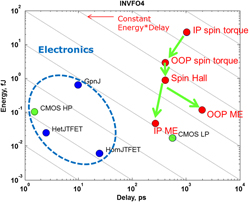Crossref Citations
This article has been cited by the following publications. This list is generated based on data provided by
Crossref.
Alzate, Juan G.
Amiri, Pedram Khalili
and
Wang, Kang L.
2015.
Handbook of Spintronics.
p.
1.
Sharma, Nishtha
Marshall, Andrew
Bird, Jonathan
and
Dowben, Peter
2015.
Magneto-electric magnetic tunnel junction logic devices.
p.
1.
Nikonov, Dmitri E.
and
Young, Ian A.
2015.
Benchmarking of Beyond-CMOS Exploratory Devices for Logic Integrated Circuits.
IEEE Journal on Exploratory Solid-State Computational Devices and Circuits,
Vol. 1,
Issue. ,
p.
3.
Alzate, Juan G.
Amiri, Pedram Khalili
and
Wang, Kang L.
2016.
Handbook of Spintronics.
p.
1127.
Choudhary, Renu
Komesu, Takashi
Kumar, Pankaj
Manchanda, Priyanka
Taguchi, Kazuaki
Okuda, Taichi
Miyamoto, Koji
Dowben, Peter A.
Skomski, Ralph
and
Kashyap, Arti
2016.
Exchange coupling and spin structure in cobalt-on-chromia thin films.
EPL (Europhysics Letters),
Vol. 115,
Issue. 1,
p.
17003.
Jamali, Mahdi
Smith, Angeline Klemm
and
Wang, Jian-Ping
2016.
Nonreciprocal behavior of the spin pumping in ultra-thin film of CoFeB.
Journal of Applied Physics,
Vol. 119,
Issue. 13,
Chang, Sou-Chi
Manipatruni, Sasikanth
Nikonov, Dmitri E.
and
Young, IAN A.
2016.
Clocked Domain Wall Logic Using Magnetoelectric Effects.
IEEE Journal on Exploratory Solid-State Computational Devices and Circuits,
Vol. 2,
Issue. ,
p.
1.
Sharma, N
Bird, J P
Dowben, P A
and
Marshall, A
2016.
Compact-device model development for the energy-delay analysis of magneto-electric magnetic tunnel junction structures.
Semiconductor Science and Technology,
Vol. 31,
Issue. 6,
p.
065022.
Kang, Wang
Ran, Yi
Zhang, Youguang
Lv, Weifeng
and
Zhao, Weisheng
2017.
Modeling and Exploration of the Voltage-Controlled Magnetic Anisotropy Effect for the Next-Generation Low-Power and High-Speed MRAM Applications.
IEEE Transactions on Nanotechnology,
Vol. 16,
Issue. 3,
p.
387.
Jaiswal, Akhilesh
Chakraborty, Indranil
and
Roy, Kaushik
2017.
Energy-Efficient Memory Using Magneto-Electric Switching of Ferromagnets.
IEEE Magnetics Letters,
Vol. 8,
Issue. ,
p.
1.
Wan, Caihua
Zhang, Xuan
Yuan, Zhonghui
Fang, Chi
Kong, Wenjie
Zhang, Qintong
Wu, Hao
Khan, Usman
and
Han, Xiufeng
2017.
Programmable Spin Logic Based on Spin Hall Effect in a Single Device.
Advanced Electronic Materials,
Vol. 3,
Issue. 3,
Sharmin, Saima
Shim, Yong
and
Roy, Kaushik
2017.
Magnetoelectric oxide based stochastic spin device towards solving combinatorial optimization problems.
Scientific Reports,
Vol. 7,
Issue. 1,
Jaiswal, Akhilesh
Roy, Sourjya
Srinivasan, Gopalakrishnan
and
Roy, Kaushik
2017.
Proposal for a Leaky-Integrate-Fire Spiking Neuron Based on Magnetoelectric Switching of Ferromagnets.
IEEE Transactions on Electron Devices,
Vol. 64,
Issue. 4,
p.
1818.
Zhang, X.
Wan, C.H.
Yuan, Z.H.
Fang, C.
Kong, W.J.
Wu, H.
Zhang, Q.T.
Tao, B.S.
and
Han, X.F.
2017.
Experimental demonstration of programmable multi-functional spin logic cell based on spin Hall effect.
Journal of Magnetism and Magnetic Materials,
Vol. 428,
Issue. ,
p.
401.
Jaiswal, Akhilesh
Agrawal, Amogh
and
Roy, Kaushik
2017.
Robust and Cascadable Nonvolatile Magnetoelectric Majority Logic.
IEEE Transactions on Electron Devices,
Vol. 64,
Issue. 12,
p.
5209.
Mankalale, Meghna G.
Liang, Zhaoxin
Zhao, Zhengyang
Kim, Chris H.
Wang, Jian-Ping
and
Sapatnekar, Sachin S.
2017.
CoMET: Composite-Input Magnetoelectric- Based Logic Technology.
IEEE Journal on Exploratory Solid-State Computational Devices and Circuits,
Vol. 3,
Issue. ,
p.
27.
Hu, Jia-Mian
Duan, Chun-Gang
Nan, Ce-Wen
and
Chen, Long-Qing
2017.
Understanding and designing magnetoelectric heterostructures guided by computation: progresses, remaining questions, and perspectives.
npj Computational Materials,
Vol. 3,
Issue. 1,
Jaiswal, Akhilesh
and
Roy, Kaushik
2017.
MESL: Proposal for a Non-volatile Cascadable Magneto-Electric Spin Logic.
Scientific Reports,
Vol. 7,
Issue. 1,
Kang, Wang
Chang, Liang
Zhang, Youguang
and
Zhao, Weisheng
2017.
Voltage-controlled MRAM for working memory: Perspectives and challenges.
p.
542.
Choudhary, Renu
Skomski, Ralph
and
Kashyap, Arti
2017.
Electric-Field-Controlled Interface Exchange Coupling in Cobalt–Chromia Thin Films.
IEEE Transactions on Magnetics,
Vol. 53,
Issue. 10,
p.
1.



